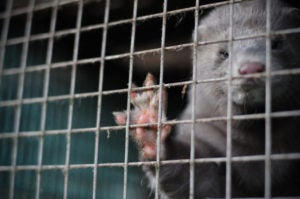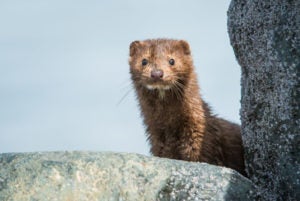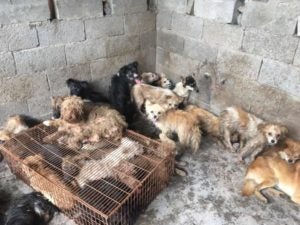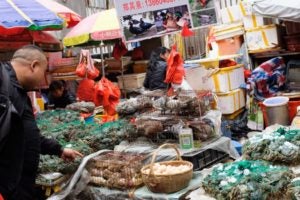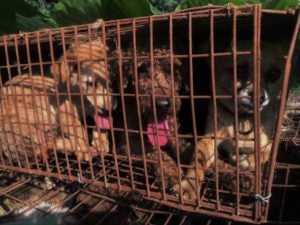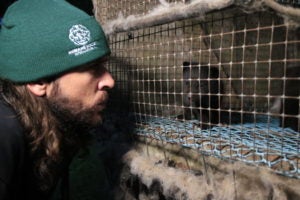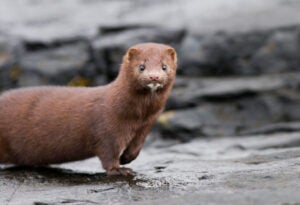
AMSTERDAM—The Dutch government has agreed that all mink fur farms must permanently close by March 2021, according to Dutch national news service, NOS. Mink fur farming was banned in the Netherlands in 2013 with a deadline for complete phase out by 2024, so this decision sees that closure fast-tracked to prevent long term COVID-19 virus reservoirs forming on affected farms.
Since April, an estimated 2 million mink have already been preventatively culled following the outbreak of coronavirus on 41 fur farms. Leading animal charity Humane Society International applauds the Dutch cabinet for ordering the early closure of fur farms in the Netherlands and closing this chapter on this animal abuse industry.
Today’s announcement will not require mink on the 120 remaining fur farms to be preventatively culled unless new COVID-19 outbreaks occur. Mink on unaffected farms will be slaughtered for their pelts in November this year, but breeders are not permitted to restock, meaning fur farms will close forever. By March 2021, all remaining mink operations will be bought out by the government.
Speaking from Amsterdam, Dr Joanna Swabe, senior director of public affairs for Humane Society International/Europe, said: “This signals the end of suffering for millions of animals confined to small wire cages on fur farms in the Netherlands. We commend the government on its decision to end this incredibly cruel and completely unnecessary industry and protect citizens. With 41 fur farms and an estimated 2 million mink now having been infected, the risk of keeping these virus reservoirs operating, is far too great. Over the past weeks, the Dutch government has failed to act as infection numbers rose. Without this early termination of fur farming, up to 13.5 million more animals would be forced to suffer short and miserable lives solely to supply the fickle fashion industry. It is a sick industry both literally and figuratively. There has never been a more compelling time for the Netherlands to shut down this industry for good”.
Last month, the Dutch Government announced its plans to implement a one-stop voluntary closing scheme that allows mink companies to voluntarily end their business operations in the short term. It requested advice from the Outbreak Management Team on Zoonosis (OMT-Z) and promised to announce its decision on future steps in August 2020. Ministers Hugo de Jonge of Health, Welfare and Sport, and Carola Schouten of Agriculture, Nature and Food Quality, together with the fur farming sector and experts, tightened the hygiene protocol since 10 July in hopes of putting the spread to bed. However, following the news of further infections, the OMT-Z was asked to elaborate on the risk assessment and measures in the light of public health. Over the course of the next months, until the termination is fully implemented, Minister Schouten will tighten up COVID-19 measures on existing operations. She will also conduct an investigation into compliance with the COVID-19 rules by the sector.
The Netherlands farmed around 4.5 million mink in 2018. Since April, two fur farm workers are believed “extremely likely” to have contracted the virus from mink.
Mink fur farms and COVID-19 timeline
- 26 April: SARS-CoV-2 identified on two mink farms in Netherlands.
- 9 May: SARS-CoV-2 found on two more mink farms in Noord Brabant as well as in dust particles in the barns in which they are kept in.
- 15 May: SARS-CoV-2 diagnosed in three cats living at a mink farm where the presence of the virus was detected.
- 19 May: First farm worker reported to have contracted COVID-19; Minister confirms compulsory screening is extended to all mink farms in the Netherlands.
- 20 May: Dutch Agriculture Minister Carola Schouten tells MPs it is likely mink infected with SARS-CoV-2 passed the virus to a worker.
- 22 May 2020: Seven of 14 employees of a mink farm in La Puebla de Valverde (Spain) test positive for SARS-CoV-2.
- 25 May: A second farm worker contracts COVID-19, Minister confirms transmission from mink to humans now “extremely likely.”
- 28 May: Ministers’ confirm mandatory screening of all Dutch mink farms is underway.
- 1 June: SARS-Cov-2 found on another three mink fur farms in the Netherlands, with a fourth case confirmed on 3 June bringing the total to nine farms.
- 3 June: Dutch Ministers publish final report confirming animals on the infected farms will be culled, a measure taken “in the interests of both public and animal health”.
- 23 June: Dutch Parliament votes in favour of shutting down all mink fur farms in the Netherlands, with early closure of farms with compensation to be paid to fur farmers to end the practice earlier than the phase out due date of 31st December 2023.
- 1 July: The Dutch Government says it will consider a one-stop voluntary closing scheme and breeding ban for mink fur farms in the Netherlands. It aims to make a decision in August 2020 and must notify Parliament before the new mating season starts in February 2021.
- 6 July: 20th mink fur farm in the Netherlands confirmed with COVID-19
- 9 July: Two more mink farms in the Netherlands confirmed with COVID-19. Another 75,000 mink culled.
- 9 July: Brabant-Zuidoost regional safety board calls on Minister Schouten to implement preventative clearing.
- 13 July: The 23rd mink fur farm in the Netherlands was confirmed as being infected with COVID-19.
- 15 July: Another Dutch mink fur farm infected with COVID-19. This brings the total of infected farms to 24. The Dutch mink death toll reaches 1 million mink, according to national media sources.
- 16 July: First farm in Spain identified with corona-infected mink. The Aragonese Minister of Agriculture, Joaquín Olona, during the press conference in which he reported the extermination of the farm with 92,700 minks Health orders to exterminate a farm of 92,700 minks invaded by the Covid in Teruel. The authorities recognize that there are indications that point to a cross contagion between humans and animals on that farm.
- 10 August 2020: 28th and 29th farm confirmed by Ministers, in Elsendorp (12,000 dams) and in Vredepeel (6,000 dams) respectively.
- 13 August 2020: 30th farm confirmed by Ministers, in Ven-Zelderheide (municipality of Gennep), with approximately 1,800 mother animals.
- 14 August 2020: 31st farm confirmed by Ministers, in Altforst (municipality of West Maas en Waal), with approximately 12,000 mother animals.
- 14 August 2020: Forth farm identified in Denmark. All four farms identified are located in North Jutland. No details of the number of mink on the farm. The mink will not be killed.
- 16 August 2020: Infections on Netherlands farms 32 and 33 confirmed by Ministers, in De Mortel and in Ottersum.
- 17 August 2020: USDA Confirms first confirmed cases of SARS-CoV-2 in mink at two farms in Utah, United States.
- 18 August 2020: Three new Dutch farms confirmed, taking the total number of farms to 36.
- 24 August 2020: Three new farm infected with Covid-19. An infection with SARS-CoV-2 has been established on a farm in De Rips, as well as in Vlierden and in Ven-Zelderheide. A total of 40 mink farms in the Netherlands have now been declared infected.
- 27 August 2020: 41st farm infected with Covid-19.
- 27 August 2020: Dutch government announce agreement to fast track the permanent closure of all mink fur farms in the Netherlands by March 2021.
Media contact:
To request an interview with HSI spokespeople (Dutch and English speakers) please contact Leozette Roode, HSI/UK: LRoode@hsi.org
Notes
Latest available figures show approximately 35 million mink were farmed in 2018 in Europe, including Denmark (17.6m), Poland (5m), Netherlands (4.5m), Finland (1.85m), Greece (1.2m) and Lithuania (1.2m). Figures for the same period show that mink were farmed for their fur in China (20.7m), the United States (3.1m) and Canada (1.7m), bringing the total to approximately 60million mink globally on fur farms.

